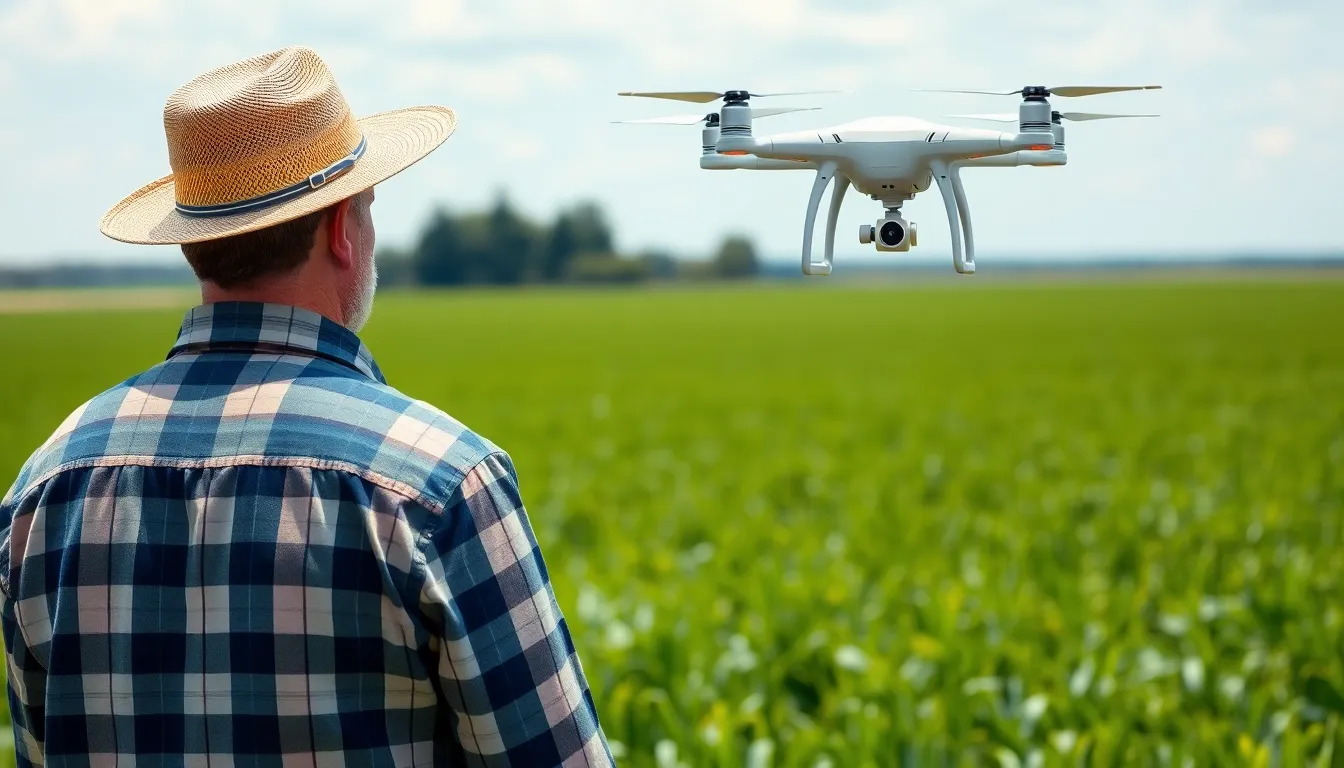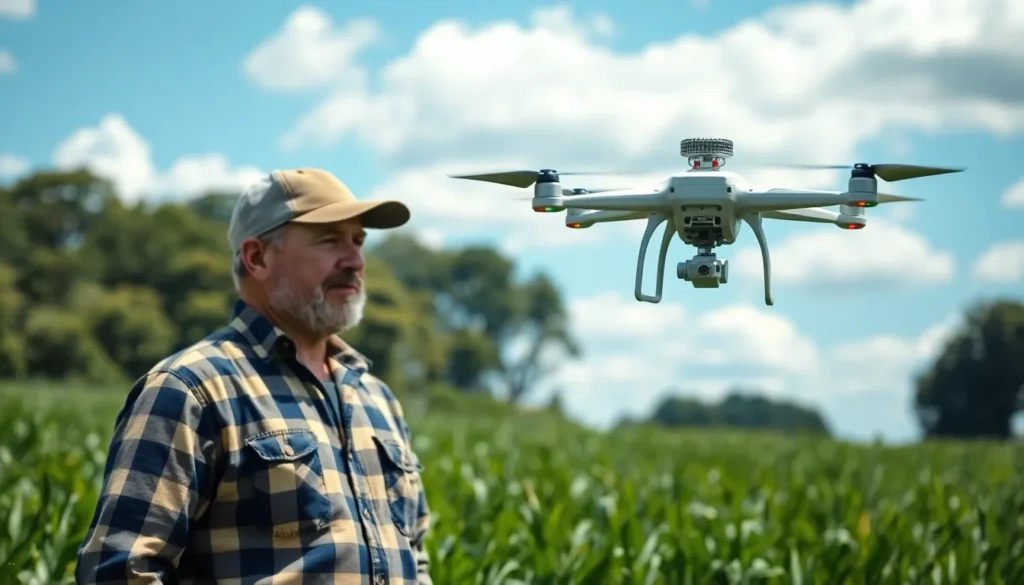Imagine a world where farmers trade in their trusty old tractors for high-flying drones that zip across fields like superheroes. Welcome to the future of agriculture, where technology meets the great outdoors, and crop management gets a major upgrade. Drones aren’t just for taking stunning aerial selfies; they’re revolutionizing how crops are monitored, pests are managed, and yields are maximized.
Table of Contents
ToggleOverview of Drones for Agriculture
Drones play a crucial role in modern agriculture, significantly enhancing farm productivity and efficiency. Equipped with advanced sensors and imaging technology, these devices provide farmers with real-time data on crop health, moisture levels, and soil conditions. This data allows for more precise irrigation and fertilization, reducing waste and optimizing resource use.
Many types of drones exist for agricultural applications, including fixed-wing and multi-rotor models. Fixed-wing drones cover large areas quickly and are ideal for mapping and surveying. Multi-rotor drones offer increased maneuverability, making them suitable for tasks like crop spraying and detailed inspections.
Current statistics indicate that drone adoption in agriculture is increasing at a rapid pace. According to a 2022 report by Research and Markets, the agricultural drone market is expected to reach $6.2 billion by 2025. This growth reflects a broad acceptance of drone technology among farmers looking for innovative solutions to traditional challenges.
Data collection through drones enables farmers to make informed decisions, enhancing crop yield by as much as 20%. By employing drones for monitoring and analyzing crops, farmers can promptly address pest infestations or nutrient deficiencies, often before they impact overall yields.
In addition to monitoring and analysis, drones facilitate precision agriculture practices. They enable targeted pesticide and fertilizer application, which minimizes chemical use and reduces environmental impact. Incorporating drones into farming practices represents a shift toward smarter, more sustainable agriculture, making it a valuable tool for future food production.
Benefits of Using Drones in Agriculture

Drones provide significant benefits that enhance agricultural practices. These devices improve productivity and allow farmers to address challenges efficiently.
Increased Efficiency
Efficiency increases with drone use. Real-time data collection allows for immediate decision-making. Tasks such as field mapping or crop scouting become faster, saving farmers time. Drones cover large areas quickly, reducing the need for manual inspections. Farmers can allocate resources better, optimizing labor and reducing costs. Studies show that farms utilizing drones see improvement in operational efficiency by over 15%, directly enhancing profitability. Planning and executing tasks align better with precise data, supporting smarter farming strategies.
Enhanced Crop Monitoring
Crop monitoring improves with drones equipped with advanced sensors. Farmers receive detailed insights into crop health, moisture levels, and nutrient status. High-resolution imagery enables the detection of issues such as pests and diseases before they escalate. Continuous monitoring ensures interventions occur promptly, reducing potential yield loss. Additionally, data analysis assists in tracking crop growth over time, fostering informed agricultural decisions. This practice can enhance crop yield by approximately 20%, demonstrating the value of timely pest management and nutrient application. Drones play a pivotal role in ensuring optimum crop performance.
Types of Drones Used in Agriculture
Various types of drones serve specific functions in agriculture, enabling farmers to optimize their operations. Each type features unique attributes that enhance farming practices.
Fixed-Wing Drones
Fixed-wing drones cover expansive areas efficiently, making them ideal for mapping large farms. High endurance allows these devices to fly for longer durations, providing comprehensive aerial surveys. Equipped with advanced sensors, fixed-wing drones collect detailed data on soil conditions and crop health. Their ability to fly high and maintain speed results in faster data collection compared to other types. In addition to mapping, they assist in crop scouting, helping farmers identify problem areas before they escalate.
Multi-Rotor Drones
Multi-rotor drones excel in precision agriculture tasks. Compact and agile, they navigate through tight spaces, allowing access to areas unreachable by larger drones. Their vertical take-off and landing capabilities make them flexible for various tasks, including crop inspections and targeted spraying. Equipped with high-resolution cameras, multi-rotor drones capture detailed images of crops, facilitating rapid assessments of plant health. Real-time data collection enhances decision-making, allowing farmers to address issues immediately. This versatility makes multi-rotor drones essential for detailed monitoring and timely interventions.
Applications of Drones in Farming
Drones have revolutionized various aspects of farming. Their applications span across several domains, enhancing the overall efficiency of agricultural practices.
Crop Health Assessment
Drones provide farmers with crucial insights into crop health. Equipped with advanced imaging sensors, they capture high-resolution images that reveal plant vitality. Regular monitoring helps detect issues like nutrient deficiencies early, allowing for timely interventions. Data from these evaluations can lead to yield improvements of up to 20%. Faster assessments also reduce the potential for extensive crop damage, ultimately supporting better decision-making for agricultural outputs.
Precision Agriculture
Precision agriculture relies heavily on drone technology. Drones enable targeted applications of pesticides and fertilizers. By analyzing specific areas in fields, farmers apply treatments only where necessary, minimizing waste and environmental impact. This data-driven approach ensures plants receive the correct amount of nutrients. Studies indicate that implementing these practices can increase farm profitability by over 15%. Enhanced accuracy through drones supports sustainable farming while optimizing resource usage, proving essential for modern agricultural strategies.
Challenges in Implementing Drones
Implementing drones in agriculture involves various challenges that farmers and stakeholders must navigate. Among these, regulatory issues and technical limitations present significant obstacles.
Regulatory Issues
Navigating regulatory frameworks poses a challenge for drone integration in agriculture. Compliance with local and national regulations often requires extensive paperwork and approvals. Farmers must consider airspace restrictions, which vary by region and can impact operational capabilities. Additionally, privacy concerns arise from aerial surveillance, leading to further regulatory scrutiny. Failure to adhere to these guidelines can result in penalties or operational setbacks. Ensuring that the technology aligns with existing laws becomes crucial for successful drone adoption in farming.
Technical Limitations
Technical limitations also hinder the full potential of drones in agriculture. Battery life remains a critical factor, as shorter flight times restrict the area covered in a single operation. Limited payload capacity affects the amount of equipment and sensors drones can carry, complicating precision tasks. Additionally, data processing capabilities can lag, delaying real-time analysis crucial for immediate decision-making. Weather conditions further disrupt drone efficiency, with high winds or rainfall impacting flight operations. Identifying solutions to these challenges is essential for maximizing drone effectiveness in modern agriculture.
The integration of drones in agriculture signifies a pivotal shift towards smarter farming practices. As technology continues to evolve, farmers are increasingly leveraging drones to enhance productivity and sustainability. The ability to gather real-time data and make informed decisions allows for more efficient resource management.
Despite the challenges posed by regulations and technical limitations, the benefits of drone technology are undeniable. With their capacity to improve crop monitoring and optimize yields, drones are set to play a crucial role in addressing the demands of modern agriculture. As the industry embraces these advancements, the future of farming looks promising, paving the way for innovative solutions that support food production and environmental stewardship.

